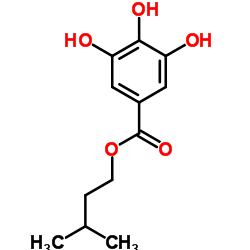Glutamate dehydrogenase (NADP)

Glutamate dehydrogenase (NADP) structure
|
Common Name | Glutamate dehydrogenase (NADP) | ||
|---|---|---|---|---|
| CAS Number | 9029-11-2 | Molecular Weight | 240.252 | |
| Density | 1.3±0.1 g/cm3 | Boiling Point | 450.9±40.0 °C at 760 mmHg | |
| Molecular Formula | C12H16O5 | Melting Point | N/A | |
| MSDS | USA | Flash Point | 174.3±20.8 °C | |
|
[Effect of growth factors and some microelements on biosurfactant synthesis of Acinetobacter calcoaceticus IMV B-7241].
Mikrobiol. Z. 75(5) , 18-26, (2013) The effect of yeast autolysate and microelements on synthesis of surface-active substances (SAS, biosurfactants) was investigated under cultivation of Acinetobacter calcoaceticus IMV B-7241 on various carbon substrates (n-hexadecane, ethanol, glycerol). The a... |
|
|
[Effect of univalent cations on synthesis of surfactants by Acinetobacter calcoaceticus IMV B-7241].
Mikrobiol. Z. 75(2) , 10-20, (2013) The effect of univalent cations on activity of key enzymes of C2-metabolism has been investigated in the producer of biosurfactants, Acinetibacter calcoaceticus IMV B-7241 grown on ethanol. It was established that potassium cations are inhibitors of pyroquino... |
|
|
[Effect of Cu2+ on synthesis of biosurfactants of Acinetobacter calcoaceticus IMV B-7241 and Rhodococcus erythropolis IMV Ac-5017].
Mikrobiol. Z. 75(1) , 3-13, (2013) Synthesis of biosurfactants (surface-active substances, SAS) was investigated under the conditions of growth of Rhodococcus erythropolis IMV Ac-5017 and Acinetobacter calcoaceticus IMV B-7241 on hydrophobic (n-hexadecane, liquid paraffins, sunflower oil) and ... |
|
|
[Production of surfactants by Acinetobacter calcoaceticus K-4 grown on ethanol with organic acids].
Prikl. Biokhim. Mikrobiol. 48(6) , 631-9, (2012) The effect of fumarate (C4-dicarboxylic acid, a gluconeogenesis precursor) and citrate (a lipid synthesis regulator) on the production of surfactants by Acinetobacter calcoaceticus K-4 grown on ethanol has been studied. Simultaneous addition of fumarate and c... |
|
|
Mitochondrial targeting adaptation of the hominoid-specific glutamate dehydrogenase driven by positive Darwinian selection.
PLoS Genet. 4(8) , e1000150, (2008) Many new gene copies emerged by gene duplication in hominoids, but little is known with respect to their functional evolution. Glutamate dehydrogenase (GLUD) is an enzyme central to the glutamate and energy metabolism of the cell. In addition to the single, G... |
|
|
Assimilation of homotaurine-nitrogen by Burkholderia sp. and excretion of sulfopropanoate.
FEMS Microbiol. Lett. 279(1) , 77-82, (2008) Homotaurine (3-aminopropanesulfonate), free or derivatized, is in widespread pharmaceutical and laboratory use. Studies with enrichment cultures indicated that the compound is degradable as a sole source of carbon or as a sole source of nitrogen for bacterial... |
|
|
Purification and some properties of the glutamate dehydrogenase of Salmonella typhimurium.
Can. J. Microbiol. 19(4) , 427-38, (1973)
|
|
|
Involvement of GDH3-encoded NADP+-dependent glutamate dehydrogenase in yeast cell resistance to stress-induced apoptosis in stationary phase cells.
J. Biol. Chem. 287(53) , 44221-33, (2012) Glutamate metabolism is linked to a number of fundamental metabolic pathways such as amino acid metabolism, the TCA cycle, and glutathione (GSH) synthesis. In the yeast Saccharomyces cerevisiae, glutamate is synthesized from α-ketoglutarate by two NADP(+)-dep... |
|
|
Aspergillus terreus NADP-glutamate dehydrogenase is kinetically distinct from the allosteric enzyme of other Aspergilli.
Mycol. Res. 113(Pt 10) , 1121-6, (2009) NADP-Glutamate dehydrogenase (NADP-GDH) located at the interface of carbon and nitrogen metabolism has the potential to dictate fungal carbon flux. NADP-GDH from Aspergillus terreus, itaconate producer and an opportunistic pathogen, was purified to homogeneit... |
|
|
Histidine is a source of the antioxidant, alpha-ketoglutarate, in Pseudomonas fluorescens challenged by oxidative stress.
FEMS Microbiol. Lett. 309(2) , 170-7, (2010) The role of alpha-ketoglutarate (KG) in the detoxification of reactive oxygen species (ROS) has only recently begun to be appreciated. This ketoacid neutralizes ROS in an NADPH-independent manner with the concomitant formation of succinate and CO(2). To furth... |